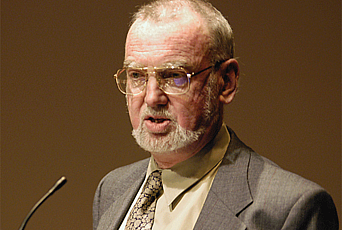The hardest science has the softest forms. Mathematics is often seen as a growing body of definitions, axioms, formulas, and theorems, all fitted together with the greatest precision. Each new proof adds extra cross-bars and tightens the nuts and bolts so that the tower becomes even stronger and can reach higher.
But this view of mathematics as a logical construction project lacks an important element. Growth is not haphazard and autonomous. Even though there is no chief architect, at least not here on Earth, there are visions that guide the building process. Some of the greatest mathematicians in history have become famous for their conjectures, formulas, or statements that are possibly true, dotted lines that suggest the next steps.
In addition, there are even bigger blueprints for the entire structure, deep intellectual undercurrents that run through many generations and disciplines. Such a mathematical “program” is a diffuse collection of interconnected facts, suggestions, and relationships, all pointing to something far greater and undefined. Some parts are proven, others are only conjectures, and nobody knows exactly how far the vision extends. It is precisely this soft side that provides mathematical guidance.
Robert Langlands was celebrated in Oslo and around the world on May 22 when H.M. King Harald V presented the 81-year-old mathematician with this year’s Abel Prize, awarded by the Norwegian Academy of Science and Letters and known as the Nobel Prize in mathematics.
Langlands, who works in Einstein’s former office, has been a professor at the Institute for Advanced Study for more than forty-five years. He discovered in the late 1960s a deep connection between two completely different parts of mathematics: on the one hand, numbers and their relations, on the other hand, geometrical patterns and their symmetries. You could say that he discovered an Escher print in arithmetic.
It is difficult to convey the enormous impact of his revolutionary idea. Langlands showed how the same formula can originate from two entirely different worlds of thought. To employ another metaphor: it is as if two chefs cooking with two entirely different recipes, ingredients, and methods of preparation, produce exactly the same dish. The shock is even more powerful because one recipe uses only the simplest ingredients: the integers 1, 2, 3, etc.
Most mathematicians are Platonists. They believe that mathematics is discovered, not invented. In a timeless world of pure logic, formulas and relations exist waiting to be found. A mathematician digs like an archaeologist in the sand in search of hidden treasures. Most of us are happy with a pot shard. A few people encounter a stone that turns out to be a part of a temple. But what happened with Langlands almost never happens: he found a Rosetta Stone. The original stone was found in Egypt by a French soldier of Napoleon and contains a text written in both ancient Egyptian hieroglyphics and Demotic script, and ancient Greek. In the mathematical variant, these inscriptions have been replaced by numbers and geometric figures.
The discovery of such a dictionary is extremely valuable, because it enables one to translate the problems of one language into the concepts of the other. If you are lucky, the perspectives and tools of one world can be used to solve a difficult question from another world. It is striking that Langlands speaks many languages fluently, among them French, German, Russian, and Turkish. Speakers of multiple languages have a sense for the expressiveness and limitations of individual idioms as well as the universal concepts that connect them.
Nobody knows the exact size or extent of the Langlands program. It keeps growing. In the meantime, it has already borne many fruits, with the most striking result being the proof of Fermat’s Last Theorem by Andrew Wiles in 1995—a conjecture that remained unproven for more than three centuries.
Will there ever be an overarching view that brings all elements together? Langlands’s program is now the Indian parable of the blind men and the elephant. One man feels the trunk, a second a tusk, the others a piece of leg, ear, skin, or tail. Each has his own idea about what this object is—a snake, a tree, a wall, a piece of rope? Langlands imagined an elephant more than fifty years ago and mathematicians, even physicists, have been trying to combine the pieces and expand his picture of it ever since.



